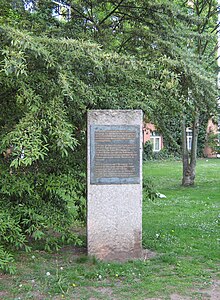New Dammtor Synagogue
The New Dammtor Synagogue was a synagogue in Hamburg's Grindelviertel . It was built in 1895 in an oriental style . It was desecrated during the November pogrom in 1938 , and private donations made it possible to restore it to such an extent that services could still take place for a while. In 1943 the building was destroyed by bombs.
history
The synagogue emerged from the Association for Jewish-Religious Lectures, which initially had a synagogue on Jungfernstieg since 1879 . It had seats for 180 men and 90 women, as well as a platform for a boys' choir who sang in church services . In 1887 the synagogue had to be closed after a fire in the roof structure.
As a replacement, after a long period of planning, a new synagogue was built in front of the Dammtor in today's Grindelviertel. The property and construction were financed by a community of heirs who rented the synagogue to the association. Torah scrolls and jewelry were borrowed from "Wallichschen Klaus ", who did not hold services at the time.
The building was built by the architects Georg Schlepps and Rudolf Rzekonski. It was located in a narrow courtyard behind the front buildings at Beneckestrasse 2 and 6 (today: Allendeplatz) and could be reached through a narrow entrance. Only the facade with the entrance to the north was designed with colored brick patterns. The doors were decorated with horseshoe arches. The entrance building was domed. It had 300 places for men and 200 for women. Inside the synagogue was decorated in color.
The service followed a rite that stood between orthodoxy and the Hamburg reform movement . A worthy worship service and quiet during prayer were important. The interior reflected the moderate changes to the Orthodox church service: the lectern ( bima ) was in front of the Torah shrine and not in the middle of the room, as in traditional synagogues. The women's gallery was barred only low. There was a gallery for a four-part choir, but no organ as in the Reform Temple.
In 1912 an association was founded under the name “New Dammthor Synagogue”. In 1924 it became an independent cultural association within the German-Israelite community, alongside the Orthodox German-Israelite Synagogue Association and the Israelite Temple Association. In this "Hamburg system", the synagogue associations could hold various forms of worship, while the higher-level congregation took on common issues such as social affairs and cemeteries.
In 1927 the synagogue was expanded by 150 seats and the interior decoration was designed by the artist Erich Brill, who also created the colored glass windows in the dome. After the association that ran the synagogue had initially acquired the entire property and the front buildings, it gave both to the German-Israelite community in 1928, which used the front buildings for administrative purposes.
Max Grunwald , who served here from 1895 to 1903, was one of the rabbis of the new Dammtor synagogue . From 1917 to 1922 the temple clergymen David Leimdörfer and Jacob Sonderling also preached in the Dammtor synagogue. These services were popular and well attended. Paul Holzer was a rabbi there from 1923 to 1939 . Holzer was arrested during the November pogrom in 1938 and was able to emigrate to England after his release.
The synagogue was devastated during the November pogrom in 1938. However, it was able to be prepared for the service again through private donations and was in operation until it was confiscated in 1943. A short time later, the building was destroyed by a bomb hit.
Today, a plaque on the site, which is now part of the Hamburg University campus , reminds of the synagogue.
See also
literature
- Irmgard Stein: Jewish monuments in Hamburg. Christians, Hamburg 1984, ISBN 3-7672-0839-3 .
- Institute for the history of the German Jews (ed.): The Jewish Hamburg: a historical reference work. Wallstein, Göttingen 2006, ISBN 3-8353-0004-0 , pp. 197-198.
Coordinates: 53 ° 34 ′ 4.9 ″ N , 9 ° 58 ′ 59.6 ″ E
